Abstract
In 1988 the World Health Assembly set the goal of global poliomyelitis eradication by the year 2000. Substantial progress has been made, and 143 countries reported no poliomyelitis cases associated with the wild virus in 1993. This article reviews the immunological considerations relevant to interrupting the transmission of wild polioviruses with vaccines. Although serum immunity prevents poliomyelitis in the individual, it is local immunity that is important in preventing the transmission of polioviruses in the community. Natural infection and vaccination with oral polioviruses vaccine (OPV) produce local immunity in the intestine and the nasopharynx in about 70-80% of individuals. In contrast, inactivated poliovirus vaccine (IPV) produces local intestinal immunity in only 20-30% of the individuals. With either vaccine, however, a substantial proportion of the immunized population can transmit the wild virus. Moreover, although serum immunity is long-lasting, limited data suggest that local immunity may not be as persistent. To interrupt the transmission of wild polioviruses efforts should be made to achieve and sustain high levels of poliovirus vaccine coverage. Recent outbreaks show that wild poliovirus poses a risk for unimmunized individuals, even when overall coverage levels are high. Delivery of poliovirus vaccine to hard-to-reach populations will be of increasing importance as countries progress toward the final stages of poliomyelitis eradication. The immunization status of persons from poliomyelitis-free countries should be updated prior to travel to poliomyelitis-endemic areas.
Full text
PDF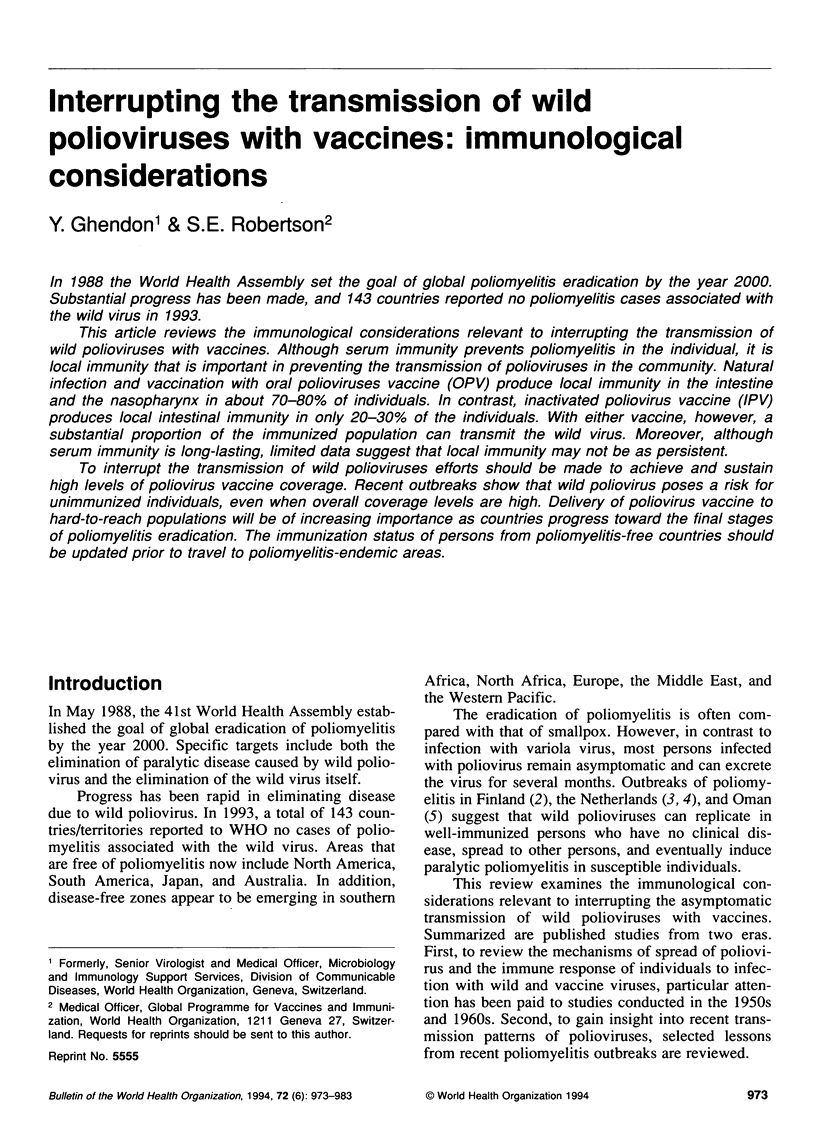
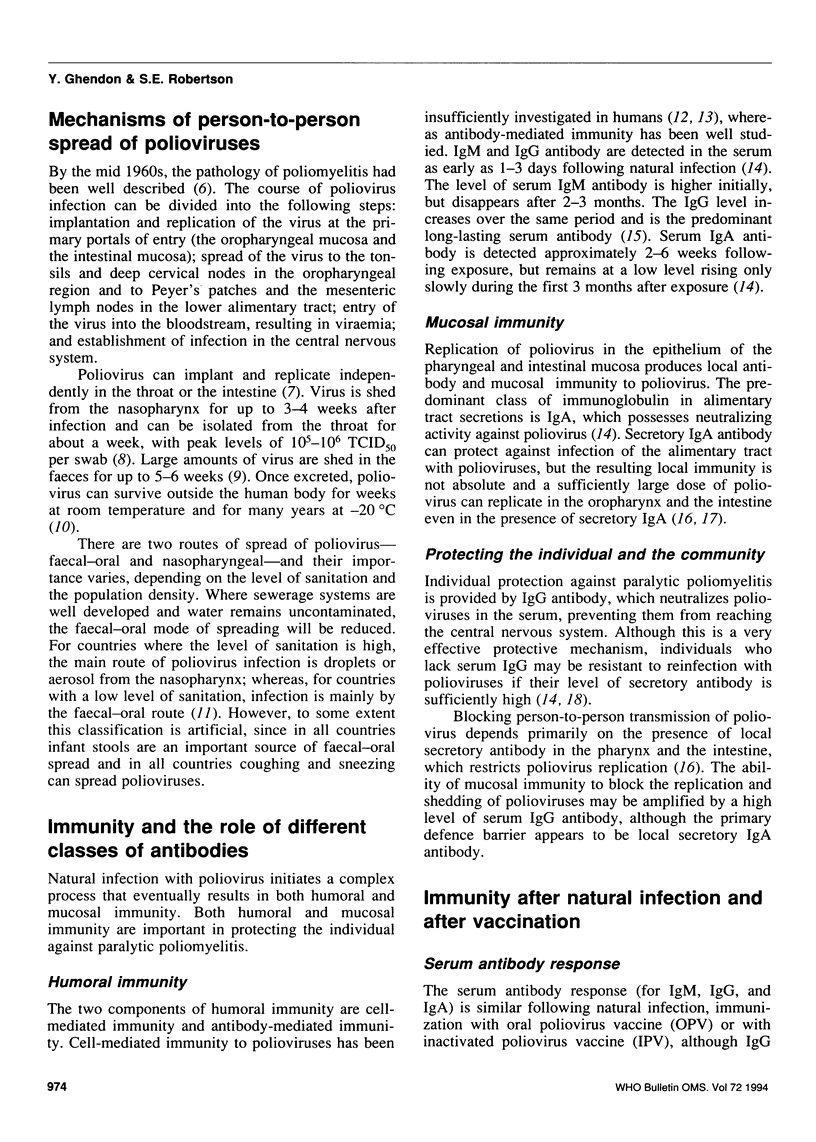
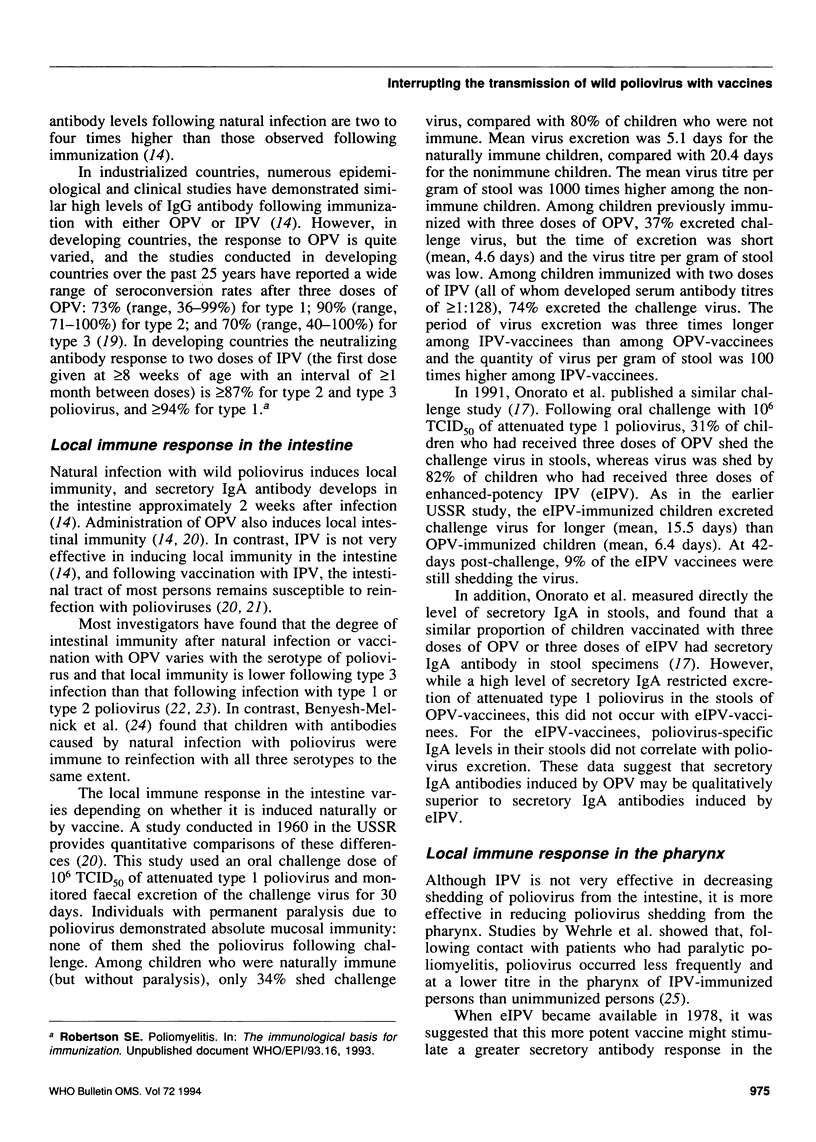
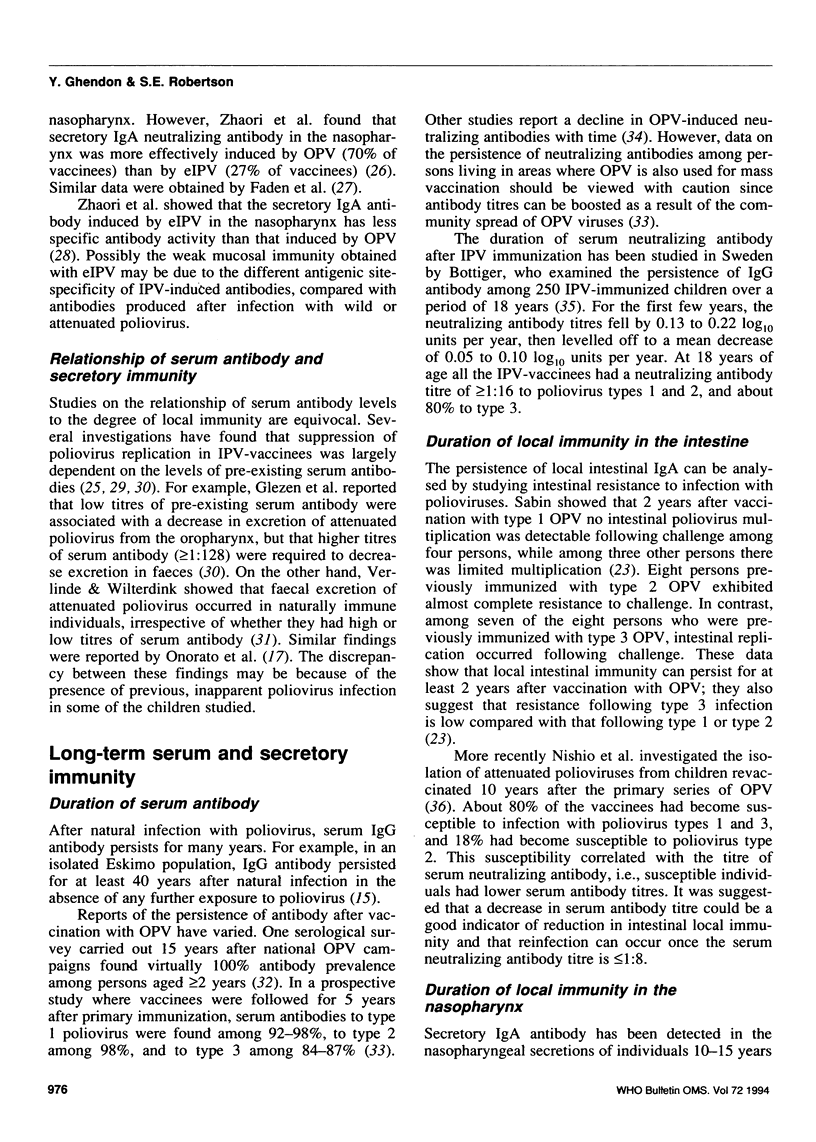
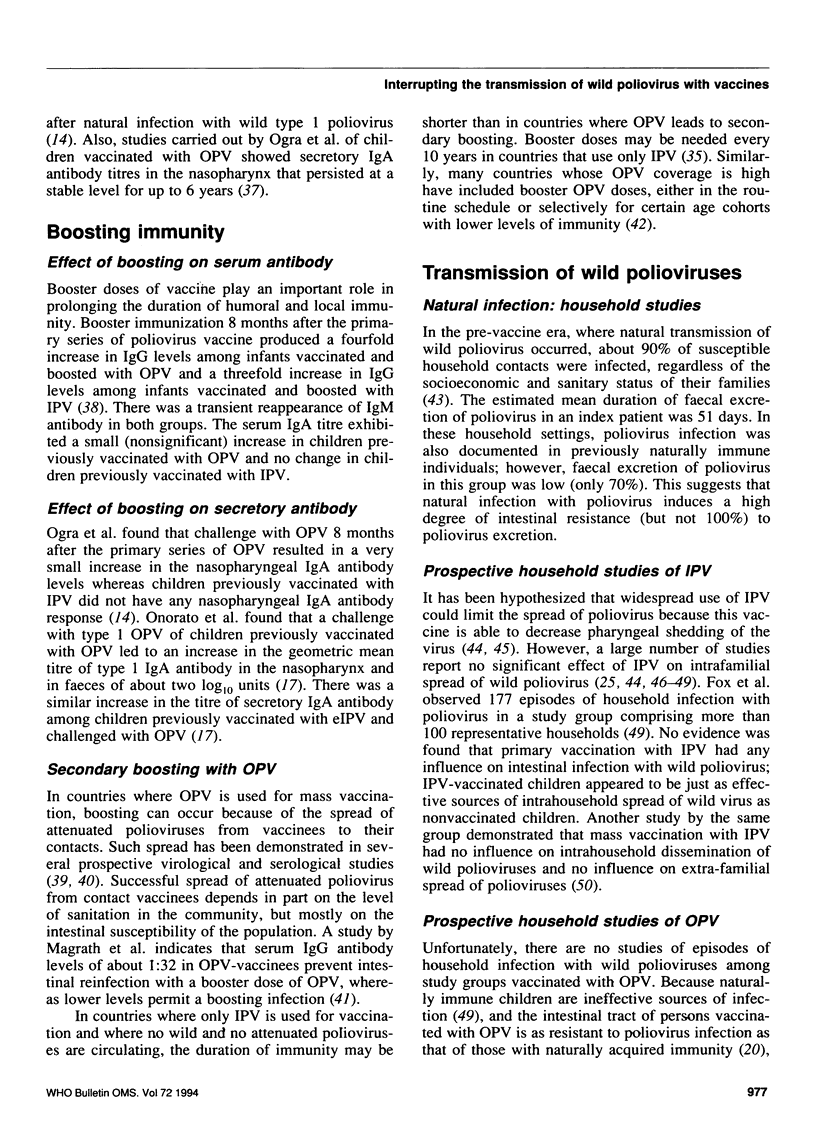
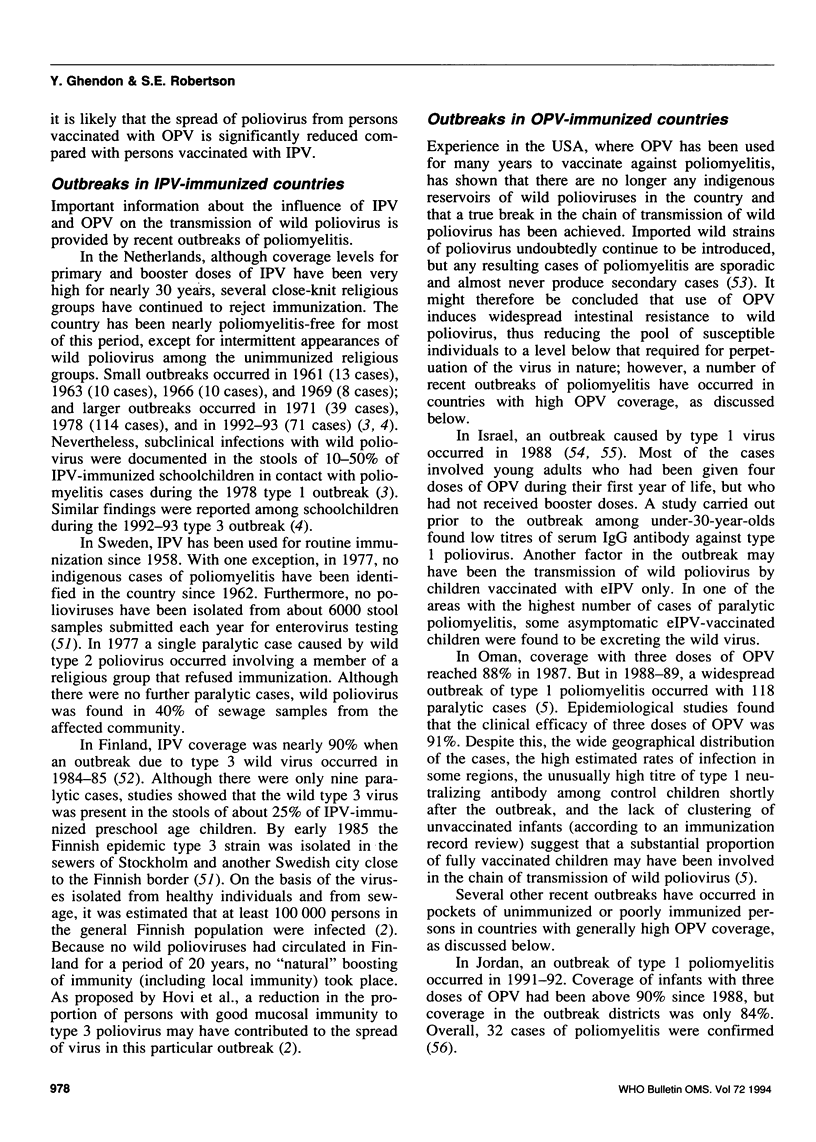
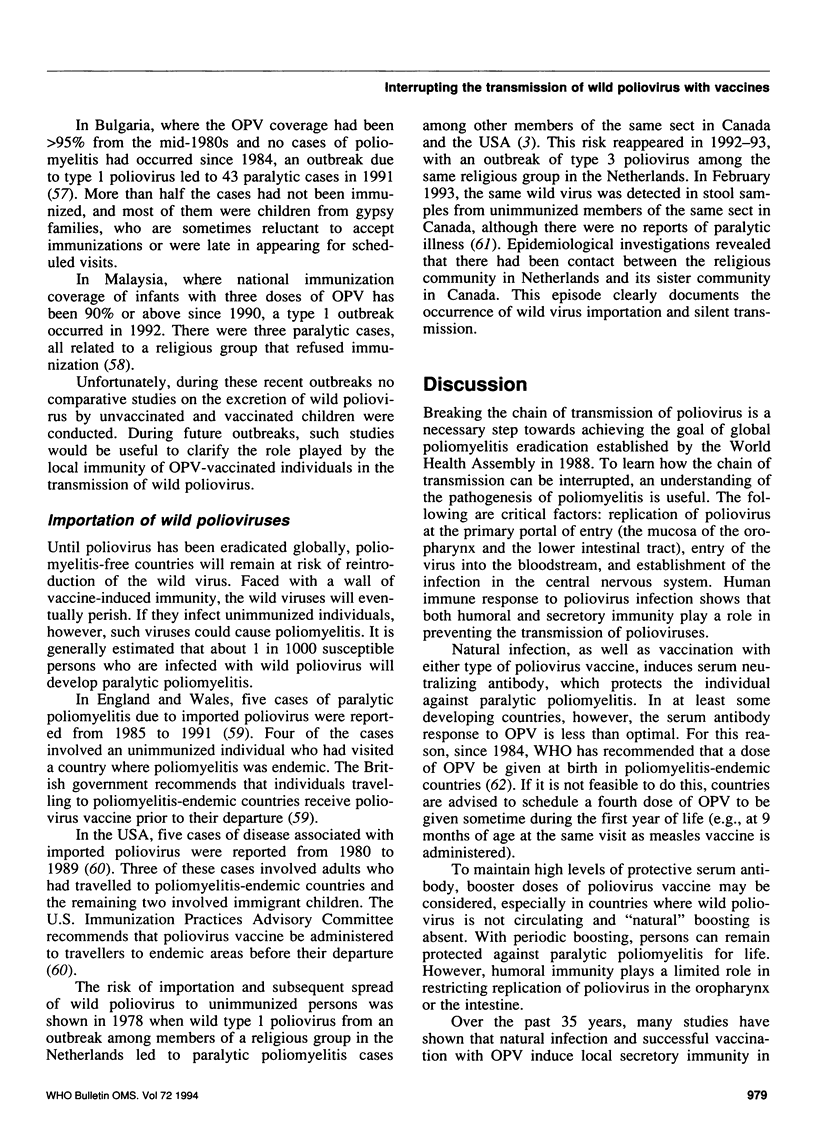
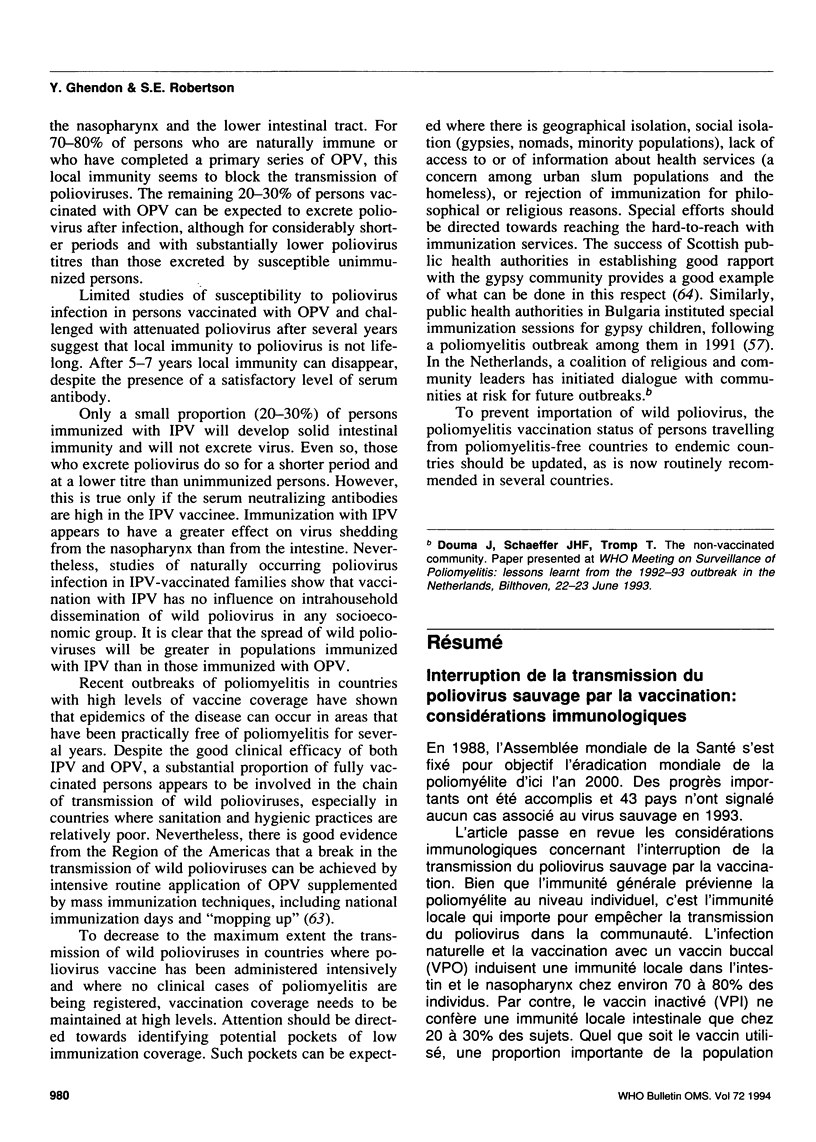
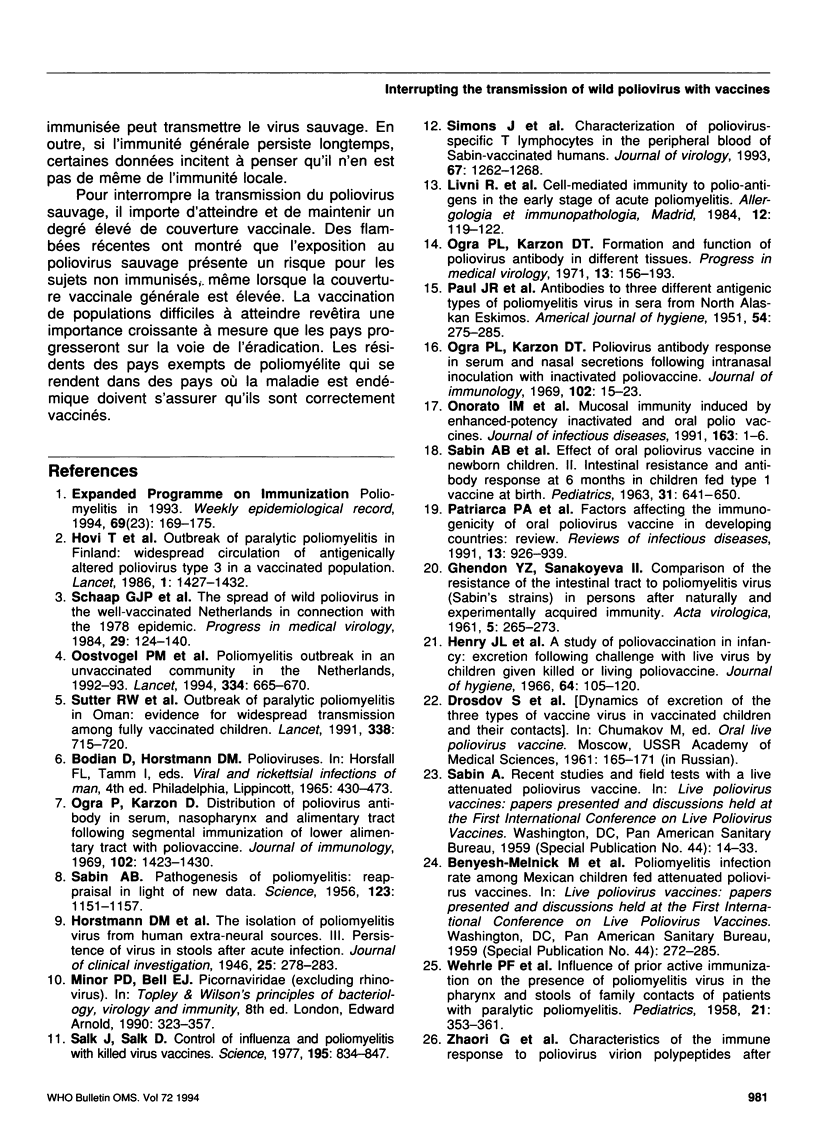
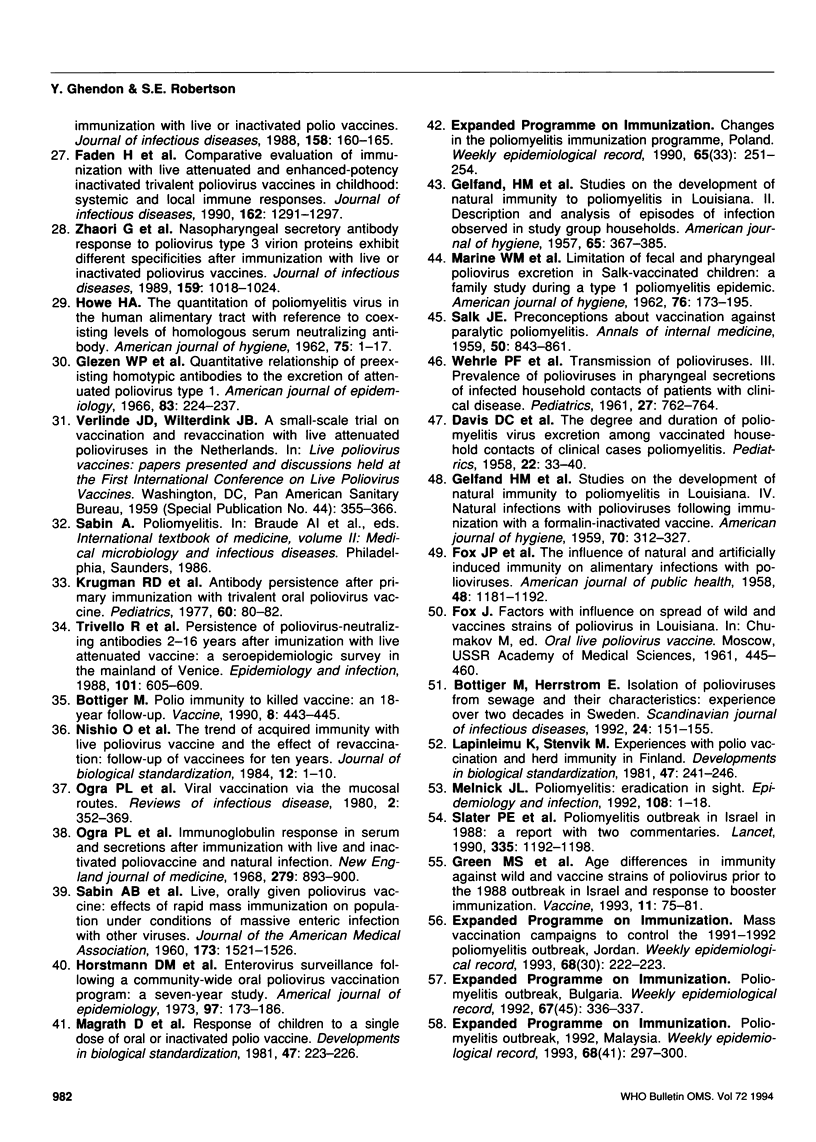
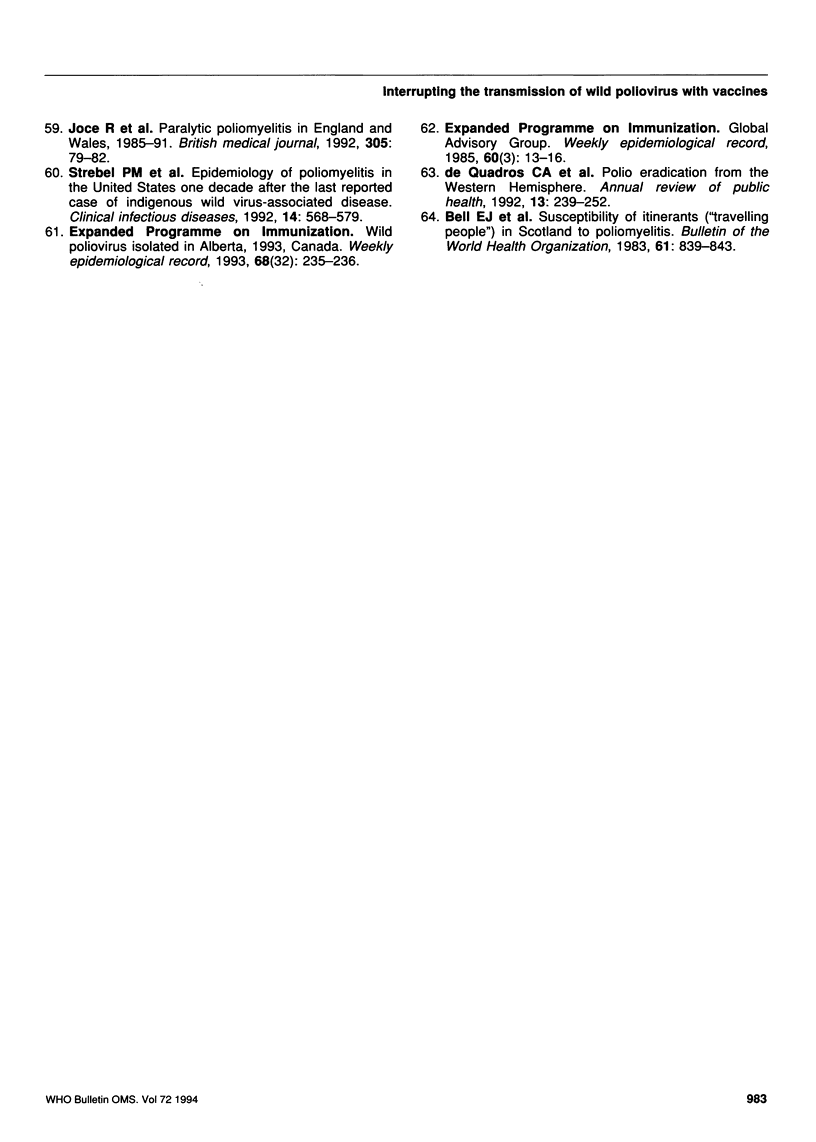
Selected References
These references are in PubMed. This may not be the complete list of references from this article.
- Bell E. J., Riding M. H., Collier P. W., Wilson N. C., Reid D. Susceptibility of itinerants ("travelling people") in Scotland to poliomyelitis. Bull World Health Organ. 1983;61(5):839–843. [PMC free article] [PubMed] [Google Scholar]
- Böttiger M., Herrström E. Isolation of polioviruses from sewage and their characteristics: experience over two decades in Sweden. Scand J Infect Dis. 1992;24(2):151–155. doi: 10.3109/00365549209052605. [DOI] [PubMed] [Google Scholar]
- Böttiger M. Polio immunity to killed vaccine: an 18-year follow-up. Vaccine. 1990 Oct;8(5):443–445. doi: 10.1016/0264-410x(90)90244-g. [DOI] [PubMed] [Google Scholar]
- DAVIS D. C., LIPSON M. J., CARVER D. H., MELNICK J. L., ROBBINS F. C. The degree and duration of poliomyelitis virus excretion among vaccinated household contacts of clinical cases of poliomyelitis. Pediatrics. 1958 Jul;22(1 Pt 1):33–40. [PubMed] [Google Scholar]
- FOX J. P., GELFAND H. M., LEBLANC D. R., ROWAN D. F. The influence of natural and artificially induced immunity on alimentary infections with polioviruses. Am J Public Health Nations Health. 1958 Sep;48(9):1181–1192. doi: 10.2105/ajph.48.9.1181. [DOI] [PMC free article] [PubMed] [Google Scholar]
- Faden H., Modlin J. F., Thoms M. L., McBean A. M., Ferdon M. B., Ogra P. L. Comparative evaluation of immunization with live attenuated and enhanced-potency inactivated trivalent poliovirus vaccines in childhood: systemic and local immune responses. J Infect Dis. 1990 Dec;162(6):1291–1297. doi: 10.1093/infdis/162.6.1291. [DOI] [PubMed] [Google Scholar]
- GELFAND H. M., LEBLANC D. R., FOX J. P., CONWELL D. P. Studies on the development of natural immunity to poliomyelitis in Louisiana. II. Description and analysis of episodes of infection observed in study group households. Am J Hyg. 1957 May;65(3):367–385. doi: 10.1093/oxfordjournals.aje.a119876. [DOI] [PubMed] [Google Scholar]
- GELFAND H. M., LeBLANC D. R., POTASH L., FOX J. P. Studies onthe development of natural immunity to poliomyelitis in Louisiana. IV. Natural infections with polioviruses following immunization with a formalin-inactivated vaccine. Am J Hyg. 1959 Nov;70:312–327. doi: 10.1093/oxfordjournals.aje.a120080. [DOI] [PubMed] [Google Scholar]
- Glezen W. P., Lamb G. A., Belden E. A., Chin T. D. Quantitative relationship of preexisting homotypic antibodies to the excretion of attenuated poliovirus type 1. Am J Epidemiol. 1966 Mar;83(2):224–237. doi: 10.1093/oxfordjournals.aje.a120578. [DOI] [PubMed] [Google Scholar]
- Green M. S., Handsher R., Cohen D., Melnick J. L., Slepon R., Mendelsohn E., Danon Y. L. Age differences in immunity against wild and vaccine strains of poliovirus prior to the 1988 outbreak in Israel and response to booster immunization. Vaccine. 1993;11(1):75–81. doi: 10.1016/0264-410x(93)90342-u. [DOI] [PubMed] [Google Scholar]
- HOWE H. A. The quantitation of poliomyelitis virus in the human alimentary tract with reference to coexisting levels of homologous serum neutralizing antibody. Am J Hyg. 1962 Jan;75:1–17. doi: 10.1093/oxfordjournals.aje.a120227. [DOI] [PubMed] [Google Scholar]
- Henry J. L., Jaikaran E. S., Davies J. R., Tomlinson A. J., Mason P. J., Barnes J. M., Beale A. J. A study of poliovaccination in infancy: excretion following challenge with live virus by children given killed or living poliovaccine. J Hyg (Lond) 1966 Mar;64(1):105–120. doi: 10.1017/s0022172400040389. [DOI] [PMC free article] [PubMed] [Google Scholar]
- Horstmann D. M., Emmons J., Gimpel L., Subrahmanyan T., Riordan J. T. Enterovirus surveillance following a community-wide oral poliovirus vaccination program: a seven-year study. Am J Epidemiol. 1973 Mar;97(3):173–186. doi: 10.1093/oxfordjournals.aje.a121498. [DOI] [PubMed] [Google Scholar]
- Horstmann D. M., Ward R., Melnick J. L. THE ISOLATION OF POLIOMYELITIS VIRUS FROM HUMAN EXTRA-NEURAL SOURCES. III. PERSISTENCE OF VIRUS IN STOOLS AFTER ACUTE INFECTION. J Clin Invest. 1946 Mar;25(2):278–283. doi: 10.1172/JCI101707. [DOI] [PMC free article] [PubMed] [Google Scholar]
- Hovi T., Cantell K., Huovilainen A., Kinnunen E., Kuronen T., Lapinleimu K., Pöyry T., Roivainen M., Salama N., Stenvik M. Outbreak of paralytic poliomyelitis in Finland: widespread circulation of antigenically altered poliovirus type 3 in a vaccinated population. Lancet. 1986 Jun 21;1(8495):1427–1432. doi: 10.1016/s0140-6736(86)91566-7. [DOI] [PubMed] [Google Scholar]
- Joce R., Wood D., Brown D., Begg N. Paralytic poliomyelitis in England and Wales, 1985-91. BMJ. 1992 Jul 11;305(6845):79–82. doi: 10.1136/bmj.305.6845.79. [DOI] [PMC free article] [PubMed] [Google Scholar]
- Krugman R. D., Hardy G. E., Jr, Sellers C., Parkman P. D., Witte J. J., Meyer B. C., Meyer H. M., Jr Antibody persistence after primary immunization with trivalent oral poliovirus vaccine. Pediatrics. 1977 Jul;60(1):80–82. [PubMed] [Google Scholar]
- Lapinleimu K., Stenvik M. Experiences with polio vaccination and herd immunity in Finland. Dev Biol Stand. 1981;47:241–246. [PubMed] [Google Scholar]
- Livni R., Lasch E. E., Englander T., El Massri M., Danon Y. L. Cell mediated immunity to polio antigens in the early stage of acute poliomyelitis. Allergol Immunopathol (Madr) 1984 Mar-Apr;12(2):119–122. [PubMed] [Google Scholar]
- MARINE W. M., CHIN T. D., GRAVELLE C. R. Limitation of fecal and pharyngeal poliovirus excretion in Salk-vaccinated children. A family study during a type 1 poliomyelitis epidemic. Am J Hyg. 1962 Sep;76:173–195. doi: 10.1093/oxfordjournals.aje.a120272. [DOI] [PubMed] [Google Scholar]
- Magrath D., Bainton D., Freeman M. Response of children to a single dose of oral or inactivated polio vaccine. Dev Biol Stand. 1981;47:223–226. [PubMed] [Google Scholar]
- Melnick J. L. Poliomyelitis: eradication in sight. Epidemiol Infect. 1992 Feb;108(1):1–18. doi: 10.1017/s0950268800049451. [DOI] [PMC free article] [PubMed] [Google Scholar]
- Nishio O., Ishihara Y., Sakae K., Nonomura Y., Kuno A., Yasukawa S., Inoue H., Miyamura K., Kono R. The trend of acquired immunity with live poliovirus vaccine and the effect of revaccination: follow-up of vaccinees for ten years. J Biol Stand. 1984 Jan;12(1):1–10. doi: 10.1016/s0092-1157(84)80015-3. [DOI] [PubMed] [Google Scholar]
- Ogra P. L., Fishaut M., Gallagher M. R. Viral vaccination via the mucosal routes. Rev Infect Dis. 1980 May-Jun;2(3):352–369. doi: 10.1093/clinids/2.3.352. [DOI] [PubMed] [Google Scholar]
- Ogra P. L., Karzon D. T. Distribution of poliovirus antibody in serum, nasopharynx and alimentary tract following segmental immunization of lower alimentary tract with poliovaccine. J Immunol. 1969 Jun;102(6):1423–1430. [PubMed] [Google Scholar]
- Ogra P. L., Karzon D. T. Poliovirus antibody response in serum and nasal secretions following intranasal inoculation with inactivated poliovaccine. J Immunol. 1969 Jan;102(1):15–23. [PubMed] [Google Scholar]
- Oostvogel P. M., van Wijngaarden J. K., van der Avoort H. G., Mulders M. N., Conyn-van Spaendonck M. A., Rümke H. C., van Steenis G., van Loon A. M. Poliomyelitis outbreak in an unvaccinated community in The Netherlands, 1992-93. Lancet. 1994 Sep 3;344(8923):665–670. doi: 10.1016/s0140-6736(94)92091-5. [DOI] [PubMed] [Google Scholar]
- PAUL J. R., RIORDAN J. T., MELNICK J. L. Antibodies to three different antigenic types of poliomyelitis virus in sera from North Alaskan Eskimos. Am J Hyg. 1951 Sep;54(2):275–285. doi: 10.1093/oxfordjournals.aje.a119485. [DOI] [PubMed] [Google Scholar]
- Patriarca P. A., Wright P. F., John T. J. Factors affecting the immunogenicity of oral poliovirus vaccine in developing countries: review. Rev Infect Dis. 1991 Sep-Oct;13(5):926–939. doi: 10.1093/clinids/13.5.926. [DOI] [PubMed] [Google Scholar]
- SABIN A. B., MICHAELS R. H., ZIRING P., KRUGMAN S., WARREN J. Effect of oral poliovirus vaccine in newborn children. II. Intestinal resistance and antibody response at 6 months in children fed type I vaccine at birth. Pediatrics. 1963 Apr;31:641–650. [PubMed] [Google Scholar]
- SABIN A. B. Pathogenesis of poliomyelitis; reappraisal in the light of new data. Science. 1956 Jun 29;123(3209):1151–1157. doi: 10.1126/science.123.3209.1151. [DOI] [PubMed] [Google Scholar]
- SALK J. E. Preconceptions about vaccination against paralytic poliomyelitis. Ann Intern Med. 1959 Apr;50(4):843–861. doi: 10.7326/0003-4819-50-4-843. [DOI] [PubMed] [Google Scholar]
- Salk J., Salk D. Control of influenza and poliomyelitis with killed virus vaccines. Science. 1977 Mar 4;195(4281):834–847. doi: 10.1126/science.320661. [DOI] [PubMed] [Google Scholar]
- Schaap G. J., Bijkerk H., Coutinho R. A., Kapsenberg J. G., van Wezel A. L. The spread of wild poliovirus in the well-vaccinated Netherlands in connection with the 1978 epidemic. Prog Med Virol. 1984;29:124–140. [PubMed] [Google Scholar]
- Simons J., Kutubuddin M., Chow M. Characterization of poliovirus-specific T lymphocytes in the peripheral blood of Sabin-vaccinated humans. J Virol. 1993 Mar;67(3):1262–1268. doi: 10.1128/jvi.67.3.1262-1268.1993. [DOI] [PMC free article] [PubMed] [Google Scholar]
- Slater P. E., Orenstein W. A., Morag A., Avni A., Handsher R., Green M. S., Costin C., Yarrow A., Rishpon S., Havkin O. Poliomyelitis outbreak in Israel in 1988: a report with two commentaries. Lancet. 1990 May 19;335(8699):1192–1198. doi: 10.1016/0140-6736(90)92705-m. [DOI] [PubMed] [Google Scholar]
- Strebel P. M., Sutter R. W., Cochi S. L., Biellik R. J., Brink E. W., Kew O. M., Pallansch M. A., Orenstein W. A., Hinman A. R. Epidemiology of poliomyelitis in the United States one decade after the last reported case of indigenous wild virus-associated disease. Clin Infect Dis. 1992 Feb;14(2):568–579. doi: 10.1093/clinids/14.2.568. [DOI] [PubMed] [Google Scholar]
- Sutter R. W., Patriarca P. A., Brogan S., Malankar P. G., Pallansch M. A., Kew O. M., Bass A. G., Cochi S. L., Alexander J. P., Hall D. B. Outbreak of paralytic poliomyelitis in Oman: evidence for widespread transmission among fully vaccinated children. Lancet. 1991 Sep 21;338(8769):715–720. doi: 10.1016/0140-6736(91)91442-w. [DOI] [PubMed] [Google Scholar]
- Trivello R., Renzulli G., Farisano G., Bonello C., Moschen M., Gasparini V., Benussi G. Persistence of poliovirus-neutralizing antibodies 2-16 years after immunization with live attenuated vaccine. A seroepidemiologic survey in the mainland of Venice. Epidemiol Infect. 1988 Dec;101(3):605–609. doi: 10.1017/s0950268800029472. [DOI] [PMC free article] [PubMed] [Google Scholar]
- WEHRLE P. F., CARBONARO O., DAY P. A., WHALEN J. P., REICHERT R., PORTNOY B. Transmission of polioviruses. III. Prevalence of polioviruses in pharyngeal secretions of infected household contacts of patients with clinical disease. Pediatrics. 1961 May;27:762–764. [PubMed] [Google Scholar]
- WEHRLE P. F., REICHERT R., CARBONARO O., PORTNOY B. Influence of prior active immunization on the presence of poliomyelitis virus in the pharynx and stools of family contacts of patients with paralytic poliomyelitis. Pediatrics. 1958 Mar;21(3):353–361. [PubMed] [Google Scholar]
- Zhaori G., Sun M., Faden H. S., Ogra P. L. Nasopharyngeal secretory antibody response to poliovirus type 3 virion proteins exhibit different specificities after immunization with live or inactivated poliovirus vaccines. J Infect Dis. 1989 Jun;159(6):1018–1024. doi: 10.1093/infdis/159.6.1018. [DOI] [PubMed] [Google Scholar]
- de Quadros C. A., Andrus J. K., Olive J. M., Guerra de Macedo C., Henderson D. A. Polio eradication from the Western Hemisphere. Annu Rev Public Health. 1992;13:239–252. doi: 10.1146/annurev.pu.13.050192.001323. [DOI] [PubMed] [Google Scholar]


